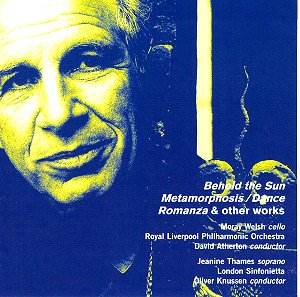Any composer in the
present climate who admits to being
influenced by Schoenberg or even liking
him is probably on a very sticky wicket.
Dizzie Gillispie, yes, Schoenberg, no.
Immediately therefore,
Alexander Goehr is set against fashion.
But then he never was fashionable, only
respected, as I recall after a performance
of his Piano Trio in London in the mid-1970s
when the best comment around was ‘that
there was not a note wasted’.
The so called ‘Manchester
school’ of composers included Max, Birtwistle
and John Ogdon, better known, of course,
as a pianist. Goehr was one of them
and they all had Richard Hall as a teacher
at one time. Goehr was the son of a
Schoenberg pupil and was interested
in what we sometimes call ‘expressionism’.
He went on to study with Messiaen and
so has tried to synthesize these two
opposite concepts, the French, where
time is divided up into frieze-like
durations and the Germanic where time
is the development and straining out
of motifs passing in a dynamic continuum.
I have to admit to be practically quoting
here Bayan Northcott’s typically challenging
notes in the useful and analytical booklet.
They are however a helpful starting
point in trying to understand why Goehr
has never ‘taken-off’ in the same way
as the other composers mentioned.
These two CDs come
from recordings which were first released
back in 1984 and 1991 and originally
appeared on the Unicorn-Kanchana label.
Of the two discs the first has possibly
the most immediate appeal. The second
(with an excellent booklet essay by
Anthony Burton) has more variety. Well
done to NMC for bringing these discs
back to life following on from the recordings
in their catalogue of the Piano Concerto/Symphony
in One Movement (NMC DO23) and of ‘Arianna’
an opera after Monteverdi {NMC D057)
Metamorphosis/Dance
is a colourful and passionate yet
readily assimilated set of variations.
Schoenberg would have recognized more
the term Metamorphosis as of
course would Richard Strauss, than Variation.
I was reminded, when I listened again,
of the opening viola melody in the Symphony
in One Movement Op. 29 which is similarly
metamorphosed, in this case into a powerful
and abstract thirty-five minute orchestral
tableau.
‘Romanza’ is
really a cello concerto written for
no less than Jacqueline du Pré
(I wonder if a recording of her performance
of the work at the Brighton Festival
in 1968 still exists?). It is good that
the work, although played as one breath,
as it were, is given five tracks to
cover the seven contrasting tempo markings
and that the theme and each of the variations
in Metamorphosis/Dance is separately
tracked.
Goehr has never had
to cheapen or distort the substance
of his music to communicate. A good
example of his style can be found, moving
to disc 2, in the ‘Lyric Pieces’.
The new Viennese antecedents are readily
apparent, but not the sweaty effortful
manner developed by some composers who
have assimilated Schoenberg. This is
very much the music of gesture and action
with each phrase thrown into a clear,
unambivalent relation to the next. You
always know what’s going on without
feeling you have read the unintelligible
manual on the origins of every note.
His homage to Bach,…..
‘a musical offering’ offers a chance
for us to grasp Goehr’s interest in
counterpoint and early music, an interest
culminating in his opera mentioned above.
This complex piece has three movements
entitled ‘Prelude’, ‘Ancient Dance steps’
and ‘Ricercar’. This is definitely no
pastiche but pure Goehr.
Goehr’s sense of colour
and his eloquent lyricism are clearly
appreciated by David Atherton on the
first disc and the London Sinfonietta
and Oliver Knussen on the second disc.
These performances were obviously well
prepared and rehearsed - a pleasure
to report. Add to that Jeannie Thomas’s
lovely coloratura soprano in the ravishing
concert aria {who writes these nowadays)
‘Behold the Sun’. Two years later this
developed into an opera of the same
name. In the opera the soprano is dressed
as a little boy who sings alone on stage
to the moon.
As I have had the original
CD since 1991 I have got to know the
‘Sinfonia’ quite well and can recommend
it. The striving first movement which
is longer than the following five combined
is as fine an utterance as anything
I know in British music of the twentieth
century.
Happily everything
is captured in clear, immediate sound
as was typical of Unicorn-Kanchana.
The other Goehr recordings
made in the early 1990s by Unicorn will
be out on NMC next year. Look out for
them. For now these recordings mark
significant milestones in contemporary
British music. If you have an inquiring
mind and a willingness to open it out
to an underrated composer of our times
then you should look out for this set.
Gary Higginson
